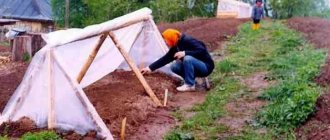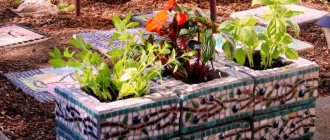- Do-it-yourself drip irrigation for your dacha at no cost: do it yourself easily and simply
- What is drip irrigation: features of the irrigation system
- Components of an irrigation system and their characteristics
- DIY drip tapes for irrigation system
- Features of using drip tubes with external droppers
- How to choose the right timers for drip irrigation
- How to make drip irrigation with your own hands from plastic pipes and hoses
- Drip irrigation from plastic bottles: features of the irrigation option
- DIY methods for organizing drip irrigation from plastic bottles
- Do-it-yourself root and surface drip irrigation from bottles
- Do-it-yourself drip irrigation for your dacha at no cost: do it yourself from medical droppers
- Review of ready-made drip irrigation systems, their characteristics
- Video: how to make drip irrigation with your own hands
Do-it-yourself drip irrigation for your dacha at no cost: do it yourself easily and simply
Today, the most popular irrigation option in a summer cottage is drip irrigation . Water falls directly under the roots of plants, so this system allows you to save on water resource consumption, facilitate the labor-intensive process of watering and increase productivity. This irrigation option can be purchased as a ready-made kit or made independently. Do-it-yourself drip irrigation for your dacha at no cost: make your own system from scrap materials.
How to water: options for an irrigation system at the dacha (read more)
Drip irrigation systems for plants are one of the most popular.
How effective is drip irrigation in a greenhouse?
When growing various crops in greenhouse conditions, it is important to understand that it is necessary to create optimal conditions for growth and development. One of the main factors is the irrigation system. You can create it yourself.
Drip irrigation system
Depending on the type of irrigation used, subject to the same conditions, it is recommended to pay attention to the following performance indicators:
- The drip system shows the highest ratio, about 90%
- Stationary: ~80%
- Portable: ~70%
- Gravity when using a whole pipe system: ~80%
- Gravity irrigation using multiple furrows: ~60%
What is drip irrigation: features of the irrigation system
Drip irrigation is a system of regular and uniform provision of moisture to the root system of plants, which helps moisten the soil directly under the planting. This type of irrigation can significantly save water. The soil does not become excessively waterlogged and does not become waterlogged between rows, as happens with other water supply options. This promotes the active supply of oxygen to the root system, which has a beneficial effect on plant growth, thereby increasing productivity.
Thanks to the drip irrigation system, water falls directly under the roots of the plant.
The drip irrigation system allows you to reduce the labor intensity of caring for green crops. And with an automated process, you can leave the area unattended for several days without worrying about the plants being left without water.
The equipment can be very diverse. But any system includes main pipelines for supplying and distributing water and outlet branches that supply water directly to the root system of each green space. The system is connected to a centralized water supply, storage tank (gravity-flow option) or to a pumping station. It can be equipped with automation, sometimes it is controlled manually. Depending on these criteria, system components are selected.
Benefits of drip irrigation
Drip irrigation has many advantages over traditional site irrigation using a watering can or hose:
- water consumption is significantly reduced, since it is supplied directionally and is not spent on moistening the entire soil and feeding weeds;
- labor costs are reduced and, as a result, time is saved;
- water does not get on the leaves of plants, which reduces the risk of fungal diseases;
- along with the water supply, you can organize root feeding;
- even when watered with cool water, plants experience less stress;
- As a rule, with drip irrigation, the root system of plants develops better, which contributes to the rapid growth of your green pets.
Components of an irrigation system and their characteristics
The main element of the system is the water supply source. It can be represented by a water supply system, a well or a water-measuring tank, which is installed at a height of at least 1.5 m. The next required element is a filter for drip irrigation with your own hands, thanks to which the system will not become clogged with various small debris.
Automatic watering system: how to make automatic watering at your dacha (read more)
The device can be vortex, disk or mesh. The latter option is considered more popular, which is due to its low cost. The vortex filter is used for irrigation systems of large areas. The disk element is characterized by excellent performance characteristics and high cost, which is not at all justified for small summer cottages.
Metal or plastic pipes are used to transport water.
If the source of water supply is a well or well, the system must be equipped with a pumping unit. The most appropriate option is considered to be a centrifugal type of device. The DIY drip irrigation distribution network consists of pipelines and hoses. For the main trunk network, metal or plastic pipes can be used. Metal products are strong, reliable and durable. However, the material is subject to corrosion, which will result in damage to the system.
Polyethylene or polypropylene pipelines are a more acceptable option. The products are characterized by strength, a smooth inner wall, which eliminates the possibility of deposits forming inside the system. Plastic pipes can withstand temperature fluctuations and the negative effects of aggressive substances.
DIY drip tapes for irrigation system
To organize outlets for each row, drip tapes in the form of a flat thin-walled tube, which has special devices for supplying water, are mainly used when arranging an irrigation system with your own hands. The tape is designed for pressure up to 1 bar. If it increases, the product may rupture. The maximum length of the tape is 100 m.
Drip tape for irrigation can be emitter or slotted.
You can buy slotted or emitter drip tape. In the first option, there is a labyrinth along the entire length of the product, which distributes water evenly. At certain distances there are holes in it to release water. This type of belt is prone to clogging, so it requires the installation of a good filter.
Inside the emitter tape there are flat droppers equipped with a labyrinth system, thanks to which water is supplied to the plants. Emitters can be located at different distances in the range of 10-35 cm, which is determined by the type of crops being watered. The lower this value, the higher the cost of the product. Emitter tape is more reliable than slotted tape, and this is reflected in the cost of the product.
When choosing a tape, you should pay attention to its thickness, which affects the strength and durability of the product. The thinnest element will last no more than one season and is suitable exclusively for greenhouses.
Features of using drip tubes with external droppers
The drip tube is made of HDPE and is rigid and durable. It is produced without holes and is intended for self-installation of external drippers. The wall thickness of the product is 0.9-1.2 mm. The material is resistant to UV rays. The drip tube can withstand pressure up to 6 bar.
Drip tubes are rigid and durable and can withstand pressures up to 6 bar.
External drippers are used when organizing drip irrigation at a dacha individually for each plant. To ensure normal operation of the system, it is necessary to have high pressure in the network. These devices can be connected through thin hoses or connected directly to the drip pipe.
There are several types of external IVs. Compensated ones are used for uniform irrigation with a very long drip tape, as well as in areas with a slope. They operate exclusively from a pressure system. Less prone to contamination by small debris. Uncompensated devices are used with a short length of drip pipe and on flat areas. This option is used for gravity flow systems from a tank. They can operate at low network pressure. There are also dropper pegs that are used for spot watering. The product is installed in the root zone of the planting.
On a note! For drip irrigation of tomatoes, cucumbers, eggplants and peppers, it is advisable to use drip tubes with external droppers.
The advantage of such pipes is that you can independently choose the installation step and regulate the volume of water released. The disadvantages include the high cost of the product (compared to drip tapes), the labor-intensive and time-consuming process of cleaning the droppers.
Drip tubes are commonly used for watering tomatoes, cucumbers, peppers and other vegetables.
How to choose the right timers for drip irrigation
When installing automatic drip irrigation, you should set a timer. It performs the following functions:
- controls the irrigation system;
- controls the operation of the pump motor;
- starts and stops water supply;
- ensures the operation of several lines simultaneously.
The timer runs on batteries. When you change them, all programs on it are saved. The device can be equipped with a water meter function. There are mechanical and electronic timers. The first option operates on a spring, providing continuous watering for up to 24 hours. Mode adjustments are made manually. Any action cannot be programmed for an indefinite time. Such a device can be used for small areas where the irrigation process is constantly controlled by the owner.
An electronic timer allows you to program the process. The device has mechanical or software control. The first option is set for one week with a watering duration of no more than 2 hours. The innovative device is a program-controlled timer with 16 commands. It can be used to irrigate crops that have different watering regimes. The equipment is equipped with an air humidity sensor. This expensive option (in comparison with other devices) is recommended to be installed for watering large areas, as well as in greenhouses.
For watering greenhouses and large areas, it is better to purchase an electronic timer.
If the system is connected to a centralized water supply or pump, you should choose a device with a solenoid valve, and for watering from a barrel by gravity - with a ball valve.
How to make drip irrigation with your own hands from plastic pipes and hoses
When arranging a drip irrigation system from ready-made components, it is necessary to opt exclusively for high-quality products so that it lasts for many years and money is not wasted. The irrigation scheme should be quite simple, with a minimum number of connectors. At the junctions of elements, the pressure weakens, which contributes to the accumulation of small particles of debris.
Installation of the system is preceded by the creation of a layout diagram of all its component elements, and this, in turn, depends on the layout of the site and the location of the beds. The diagram should indicate the source of water supply, the main pipe and outlet hoses so that you can calculate the amount of materials needed. It is better to use a plastic barrel as a source of water supply for drip irrigation. This material does not corrode, which will not only increase the service life of the product, but also eliminate the possibility of clogging the system with rust particles.
Polypropylene pipes for drip irrigation are more preferable.
A main pipeline, which can be made of metal or plastic, is connected to the water supply source. A more preferable option is to lay polypropylene drip irrigation pipes with your own hands. The main branch is located perpendicular to the beds and has a larger diameter than the outlet pipelines. All do-it-yourself drip irrigation elements made from plastic pipes are connected with compression fittings. After the shut-off valve of the water supply, a coarse filter is installed on the main line.
If drip tapes are used as outlet pipelines, then holes are drilled in the line for their fastening using starting fittings. The hoses are placed as close to the row of plants as possible. A plug is installed at the end of each tape. Next, the system is checked for functionality.
If you plan to lay the system underground, you need to dig a trench 30-70 cm deep under the pipelines. You need to fill the bottom with a layer of crushed stone and lay the assembled system. Next, it is tested, after which it is backfilled with soil. You can study the installation process in detail in the video of drip irrigation at the dacha.
Note! Drip irrigation pipelines laid underground are highly susceptible to clogging.
To make drip irrigation, you need to purchase high-quality components.
How to make drip irrigation in a greenhouse or on a plot
Before asking a question about how a dripper works in a greenhouse, it is important to install the equipment to ensure constant soil moisture.
Schemes of drip irrigation systems
To view images just click on any of them
Installation of drip irrigation
It is important to remember that there must be enough water in the reservoir to fully charge the siphon . This element is presented in the form of an arc-shaped pipe, where one end must be immersed in water and the other must be left open. It is subsequently connected to a ready-made system, which in the future will produce irrigation.
Homemade siphon for drip irrigation
The height of the siphon should be selected depending on how much liquid is used. Through this tube, water moves towards the irrigated area. Each summer resident can independently adjust the water supply.
During the installation process, special attention must be paid to the process of fastening the pusher . Its lower end should be attached to the lever, and the other to the tank lid. To create such a system, it is worth remembering the principle of operation of an ordinary float in a toilet cistern.
It is important to know that the rate at which liquid is removed from the surface of the earth directly depends on the depth from which it rises. Accordingly, the deeper the plant’s root system is located, the slower the moisture removal occurs.
It has been proven that almost half of the total water supply is accumulated by plants from the layers of the upper soil. Speaking of other plants, where the root system does not go deeper than 25 cm, most often they die due to drought. Therefore, in the process of installing your own drip system, it is important to take into account the peculiarities of planting rooted plants and how deep the roots can sink in the future.
Root depth of cultivated plants
Speaking of the emergency system , which must be attached to the pusher. It must have a special glass and a special valve through which excess liquid or moisture will drain. Water enters the glass only after the tank is completely filled. When the tank overflows with water, the glass fills and closes the valve, which, in turn, stops the flow of water into the tank. The valve opens only after the water has passed the top mark of the glass. In order to correctly calculate the installation of your own drip irrigation system, it is recommended to pay utmost attention to pressure indicators.
The basic principle of operation is the following drip irrigation system: as soon as the special clamp begins to move and shift towards the annular groove, the balls begin to fall through and fix the rod. As a result, the liquid can move easily, since there are no longer any obstacles to it.
Drip irrigation from plastic bottles: features of the irrigation option
From plastic bottles and canisters you can make not only decorative elements for beautifying the territory. Of these, a full-fledged drip irrigation system is organized at the dacha site, which allows the soil to be moistened for 3-4 days.
Based on numerous reviews, it is advisable to perform drip irrigation from plastic bottles from containers with a volume of up to 2.5 liters. The saturation of water in the soil depends on the type of soil; this determines the number of holes in the container, thanks to which sufficient moisture will be ensured, which will eliminate the possibility of overfilling or underfilling. For example, sandy soils absorb moisture well. In this case, 1-2 holes in the bottle will be enough, and for heavy soils a larger number should be provided. Bottles with a capacity of 1 liter provide drip irrigation of cucumbers and tomatoes for 4-5 days, 3 liters for 10 days, 6 liters for 14-15 days.
It is advisable to organize drip irrigation using plastic containers in small areas. For large areas, it will take too much effort and time to refill the container with water.
On a note! The plastic system can be used to feed and fertilize various crops.
The principle of irrigating plants using plastic bottles.
The main advantages of creating drip irrigation from plastic containers:
- significant water savings;
- minimal financial costs for organizing the system;
- individual approach to each green space;
- simple installation, operation and maintenance;
- targeted supply of moisture and fertilizing.
The disadvantages of the system include the following:
- frequent clogging of the system due to the inability to install a filter;
- unaesthetic appearance of the site;
- constant manual replenishment of water;
- on the hot days of hot summer, the plastic system may not be able to adequately supply the plants with water.
Using plastic bottles you can make a complete irrigation system.
On a note! You can create a filter for each bottle by using nylon tights.
Drip irrigation from a barrel
There are some nuances in this matter. For example, gardeners often notice that gravity flow is not a reliable and not intensive enough method of watering. And the pump is an extra. spending. Therefore, there are several ways to speed up the process. One of them is to raise the barrel not by 1.5 meters, but by three. This technique will also help prevent stagnation, and as a result, the accumulation of plaque.
But inside the barrel, the amount of litter can become many times larger, because due to the fact that it stands high, it is not always convenient to climb up in order to remove unnecessary content. Therefore, a filter directly inside the container is an excellent solution. You can, of course, follow the example of some craftsmen and use ordinary nylon for this. But a factory filter is not that expensive.
The removal of the pipe from the canister also has its own characteristics. You will need to organize a tap, after which there is a filtration system, and then you will need an adapter made in the shape of a 90-degree angle.
DIY methods for organizing drip irrigation from plastic bottles
There are several ways to create drip irrigation from plastic containers. The system can carry out surface and subsurface irrigation.
Underground homemade drip irrigation of roots using plastic bottles can be done in several ways. The most popular option is to dig containers between adjacent bushes to a depth of 10-15 cm, bottom down. Along the entire bottle, before it begins to narrow towards the neck, holes should be made using a gypsy needle or awl, 3 cm away from the bottom of the container. The average number of holes is 10-12 pcs. for containers of 2 liters. A container wrapped in thin fabric is dug into a previously prepared hole, filled with water and closed with a lid.
As the container is emptied, which occurs under the pressure of the earth, it may become deformed. To avoid this, you should pierce a hole in the lid to equalize the pressure, and you should also replenish water supplies in a timely manner.
The most popular option for irrigation from a plastic bottle is digging the container between the plants.
Another similar option is to place the container with the lid down. To use this method, you need to cut off the bottom of the bottle and screw the cap onto the neck. Holes are made throughout the entire area of the container, not reaching the top by 2-3 cm. The bottle, pre-wrapped in gauze, is placed in the hole and filled with water. To prevent debris from falling into the water, the container is covered on top with a previously cut bottom.
Do-it-yourself subsoil drip irrigation for your dacha can be organized using special oblong-shaped nozzles with holes. They can be bought in specialized stores for summer residents and gardeners. The nozzle is screwed onto the neck of the container instead of the lid. In this case, you should use bottles with a capacity of up to 2.5 liters, since there are no such devices for containers of 5-6 liters. The bottle, neck down, is inserted into the ground to the depth of the nozzle. The bottom of the container does not need to be cut off. After emptying the container, the tip is unscrewed, it is filled with water, and the manipulation is repeated.
Step-by-step installation of a drip irrigation system
Drip irrigation: correct installation
Preparation
1 Before proceeding with procurement, and even more so with installation of the system, it is necessary to make a preliminary calculation. You can do this yourself by studying the issue on the Internet. Entrust this to specialists, providing them with all the necessary data. This is the size of the area for irrigation and information about the crops grown.
2 Purchased parts were used for installation:
- Filter;
- Threaded fitting;
- Flexible hose;
- Adapters;
- Cranes;
- Bushings;
- Pipes (flexible and drip irrigation)
A container (barrel) can also be purchased. It can be either plastic or metal. In the example, a barrel already existing on the site was used.
Irrigation system parts
3 Next, you need to install the container. It needs to be securely fixed above the level of the beds so that the water flows by gravity to the watering site.
Installing the container
4 When the barrel is placed, a hole is drilled in it. A threaded fitting is inserted there. The nut of the fitting tightly presses the rubber gaskets to the walls of the barrel. This achieves a high degree of tightness.
Threaded fitting
When installing fittings for water systems, you need to use sealing tape or tow. These materials provide good tightness of threaded connections.
Installation of water supply
5 The first thing to install on the fitting is a regular ball valve.
Ball valve installation
6 Then a special filter is attached. It is necessary to prevent dirt and solid particles from entering the water, which can clog the holes in the drip hose, thereby disrupting the operation of the system.
Mounting a special filter
7 Next, connect the flexible hose. It leads water from the location of the barrel to the “main” pipe, which distributes the water over drip tapes. For laying the “mainline”, a product made of PVC or HDPE is suitable.
Connecting a flexible hose
8 The flexible hose can be attached to a rigid plastic pipe using a special adapter. It is also permissible to use a tee if wiring in two directions is planned.
Flexible hose can be attached to rigid plastic pipe
9 Then “main” pipe is laid along the beds.
Laying the “main” pipe along the beds
Installation of drip tape
10 Holes are drilled in the rigid pipe to install fittings. The holes are placed opposite the plants so that the next drip tape passes between the rows and can provide continuous watering.
Holes for installing fittings
11 The thin end of the fitting is inserted into the rigid pipe until it clicks. Then the pipe must be pressed at the insertion point. This is done using a plastic nut on the fitting. No special tools are needed for tightening - this operation can be easily done by hand.
Fitting the fitting
12 Drip irrigation tapes are attached to the fittings. Their length should correspond to the width of the bed in order to provide water to all existing plantings.
Attaching drip irrigation tapes
13 The flexible tube is placed on the plastic and fixed to it by reverse rotation of the plastic nut. Then the tapes are stretched across the entire width of the bed.
The system is ready for use
Check the tightness of the connections to avoid excess water consumption. And also so that puddles and wet spots do not form where this is not provided.
The system is ready for use. You can run water and after a very short period of time the result will be visible - the soil around the watered plants will be moistened.
This drip irrigation system is assembled only from purchased materials. The components are not expensive, but if desired, individual elements can be replaced, made independently, or improved.
Do-it-yourself root and surface drip irrigation from bottles
Using plastic containers, you can carry out root drip watering of the garden, directing drops of water directly under the root of each plant. For this method, it is better to choose a 1.5 liter container. A hole is made in the central part of the lid using a nail. Next, you should cut the bottom of the bottle at an angle of 30-40 degrees. The container itself will be located at the same inclination relative to the ground. The container is secured with several sticks and tape as close to the bush as possible, tilting the neck in such a way as to ensure that water gets directly under the rhizome.
Another option, often used in a greenhouse, involves watering the plant from a distance. To do this, take a small container and a regular ballpoint pen, previously cleaned of paste residues with gasoline or solvent. One end of it is tightly closed with a toothpick or match. The other is inserted into the opening of the bottle. It is better to seal the joint with plasticine.
Drip irrigation from plastic bottles can be root and surface.
It is necessary to make holes in the rod, the number and size of which will depend on the required intensity of moistening. It is directed under the root of the plant, depending on which the bottle is dug into the ground to the required depth. The container is filled with water and closed with a lid.
For a small area, you can make a hanging system. To do this, a support is built over the bushes, a metal rod or wire is stretched, from which the bottles will be suspended. A series of small holes should be made in the bottom or lid of the container, which depends on its location. The main advantage of this method is that the water will flow to the plant warm due to the fact that it is heated by the sun.
The container is hung above the bed at a height of 30-50 cm from ground level. The location of the bottle should be chosen based on the optimal contact of drops under the plant, and not on its leaves.
On a note! You shouldn't make a lot of holes at once. They can be added as needed to increase water supply.
If the irrigation area is small, then you can make a hanging system.
Tips for drip irrigation
- It is not difficult to guess that there are moments when the system is subject to maximum loads. As a rule, this is spring time. To keep the system running properly, it is essential to ensure that the drippers do not become clogged . Some summer residents who decide to use an automated system purchase special battery controllers that help monitor pressure parameters.
Automated drip irrigation system
- According to reviews from many experienced gardeners, when using a self-made irrigation system, it sometimes happens that when watering, the water begins to run out before reaching the end of the bed. Therefore, it is very important to monitor the pressure , since due to too much pressure, the water can oversaturate the beds, which is highly undesirable. After all, the drip system does not involve much evaporation, which means the roots can rot.
- To make the task easier, it is recommended to purchase a special dispenser . You can buy it in every store, or make it yourself from the most ordinary plastic bottle. Surprisingly, such a simple detail will help regulate the supply, both to individual plants that require abundant watering, and to certain beds.
- One of the main elements of the entire system is the creation of droppers. In this case, they can be made, for example, from plastic tubes , which are used for blood transfusions.
Droppers from bottles and tubes
Do-it-yourself drip irrigation for your dacha at no cost: do it yourself from medical droppers
Another economical option is to install a drip irrigation system using medical droppers. It is rational to arrange it in areas with different varieties of crops, which should be watered in different quantities. This procedure is made possible due to the fact that the droppers are equipped with special control wheels that allow you to select the required intensity of liquid flow. The disadvantage of such a system is that the droppers quickly become clogged, which requires periodic flushing.
To create a drip irrigation system with your own hands, you should prepare:
- disposable medical droppers;
- hoses for distributing water over the beds;
- connecting and shut-off valves for droppers and hoses.
On a note! It is recommended to choose all components in a dark color, which will prevent water from blooming in the system.
Irrigating plants using medical drippers is a simple and economical option.
Before installing such a device, you should display on a piece of paper a drip irrigation scheme, which is carried out based on the location of the beds where irrigation should be provided. Based on this, surface distribution of supply pipes is carried out on the site. For this you can use polyethylene or rubber products. All elements are connected using tees. A plug must be installed at the end of each hose.
The system can be connected from a centralized water supply or from a storage tank located at a certain height. Also in this case, you can create automatic watering by installing a timer or controller at the beginning of the system. A hole is made in the distribution pipes opposite each plant into which the plastic end of the dropper is inserted. Tubes of elements are placed under each bush.
On a note! In order for the drip irrigation system from medical droppers to last as long as possible, a fine filter should be installed at the very beginning (after the water supply source).
Drip irrigation device
Before organizing spot watering in a greenhouse with your own hands, it is important to familiarize yourself with its components.
Water tank
It is important to understand that water must enter the unit from somewhere. This could be a pipeline, a well, a separate well, a barrel . In the latter version, it should be installed at a height of 2-3 meters. highly not recommended to use open sources (rivers, lakes) , since often during the season they begin to bloom and a large amount of algae appears.
Barrel for drip irrigation
If the recommendations are not followed, the drippers can quickly become clogged, which will create an obstacle to watering. Speaking about the arrangement of industrial equipment, to use water from rivers, first, special filters are installed, which require considerable financial investments.
Pressure supply regulator (tap)
To organize high-quality watering in a greenhouse with your own hands, it is extremely important to control the power when connecting the device. If the indicator is more than 100 kPa, then it is necessary to purchase a device that helps reduce the pressure parameter.
Drip irrigation tap
Main pipe organizing the distribution pipeline
Depending on the area on which the pipeline is planned to be used, the appropriate diameter is selected. So, for example, if the area has average parameters, it will be sufficient to use a diameter of up to 32 mm . To purchase such a model, you should go to an ordinary hardware store.
Pipe for drip irrigation
It is highly not recommended to choose a model made from recycled materials, as it will quickly become unusable due to exposure to natural phenomena.
Ribbon
Drip irrigation systems for a greenhouse cannot do without tape. In the polyethylene version, it takes the form of a tube when properly filled. It is equipped with special droppers, through which drip irrigation occurs.
Drip irrigation tapes
It is important to note that different manufacturers state recommended plant spacing. For example, the Italian manufacturer Aqua-TraXX AE recommends installing droppers at a distance of 15 cm.
Filter
In order for plants to grow quickly and not get sick, it is extremely important to ensure that water reaches the root system without oxides of metal compounds. Also, the likelihood of clogging of the droppers is reduced several times; accordingly, there is a constant supply of water.
Filter for drip irrigation
It is recommended to use a filter even if the water comes from a proven source, but its cost is an order of magnitude higher than when using tape alone.
Unions and fittings
Without this, the device cannot exist as a drip system as such, since all elements are connected together due to the fitting.
Fittings are also used - special devices that secure the tapes using a rubber seal. Additional devices are needed for comfortable installation and further operation.
Drip Irrigation Fittings
Review of ready-made drip irrigation systems, their characteristics
The Zhuk drip irrigation system from a domestic manufacturer is one of the most popular among gardeners. It can be connected to a centralized water supply or to a storage tank. If you use the latter option, the kit includes a level tube, through which you can control the amount of water remaining in the barrel. Manufacturers produce “Zhuk” drip irrigation systems for 60 plants and 30 plantings. Usually the device is equipped with a timer and a filter. You can additionally buy “Zhuk” drip irrigation, designed for 20 plants.
The ready-made drip irrigation system “Zhuk” is the most popular on the domestic market.
“Kaplya” irrigation kits are equipped with emitter tapes with dropper pitches of 0.3 m. Thanks to the complex labyrinth of channels inside the dropper, the possibility of clogging is eliminated. The system is designed for an area of 25 m2. Can be connected to both a water supply and a storage tank. The controller is not included in the set.
A more reliable analogue of the Zhuk irrigation system is the Water Strider model, which is designed for drip irrigation of small greenhouses. The set consists of a 12 m long hose, a controller, 40 drippers and connecting elements. The system is organized for watering exclusively from the container, since the operating pressure in the network should not exceed 1 bar. The barrel is most often located at a height of 50 m.
The Belarusian drip irrigation system “Akvadusya” has several varieties suitable for watering areas of different sizes. It can be equipped with or without a controller, connected to a water supply or storage tank.
Drip irrigation "Urozhay"-1 is also produced with long-length emitter tapes. The system can be additionally equipped with a filter and automation. Another budget option is the Pomodor drip irrigation system with drip tubes, external drippers and a timer. The kit also includes special splitters to facilitate installation of the system. The most expensive model contains a controller and a submersible pump.
Scheme of operation of the drip irrigation system "Aquadusya".
The Istok irrigation system includes a 25 m drip tube with a pitch between droppers of 30 cm. The device is equipped with a filter and fittings necessary for connection to a storage tank. Some models are equipped with a controller and pump.
Today you can buy a drip irrigation system, which includes all possible elements. But such a solution requires significant financial costs. A more economical option is to create such a mechanism from ready-made components. In addition, you can make your own irrigation system for your dacha using scrap materials, such as plastic bottles and medical droppers. The choice depends on the nature of the territory, its area, the number and type of green spaces, personal preferences and financial capabilities of the owner.
Drip irrigation beetle
This popular installation has won the trust of gardeners. This is because the manufacturer is domestic, and the cost is not scary. And there is a choice. Is your budget quite modest? – a drip irrigation system without automated devices is suitable. This kit contains:
- All necessary hoses and pipes
- Cleaning system
- Droppers
- Tap
- Lots of adapters and connectors.
As for the area for which the kit is purchased, in its standard form it is 18 square meters when it comes to open ground. If you plan to install it in a greenhouse, then for one that is six by three meters in size, it will be quite enough. To make it easier to navigate, keep in mind that these are about 60 plants. If you take a greenhouse kit, then divide all these numbers by two.
If we talk about water sources, there is a set for the tap version. Everything is automated there. Just keep in mind that not all plants will appreciate this approach. After all, the liquid coming from the centralized system is icy.
Therefore, tomatoes or cucumbers will not appreciate such devices. But radishes or peas are fine. There is also a kit for the container. And it may or may not be equipped with automation. In general, drip irrigation has many advantages:
- The manufacturer understands the importance of cleaning, so the filter is always included
- Specialist. a drill, which can easily be used to make the correct holes for joining hoses and pipes, is also included in the list of components
- Not bad droppers that will not fail in a matter of days. They have a specific system, i.e. from one outlet there are two droppers at once on opposite sides
- Cranes, as a rule, are not one, but several
After purchasing the kit, do not rush to launch it. Straighten the main soft pipe and let it rest in this state. To make it easier to install water “dispensers” into the hose, you can heat them, but not with an open flame, but in boiling water.











